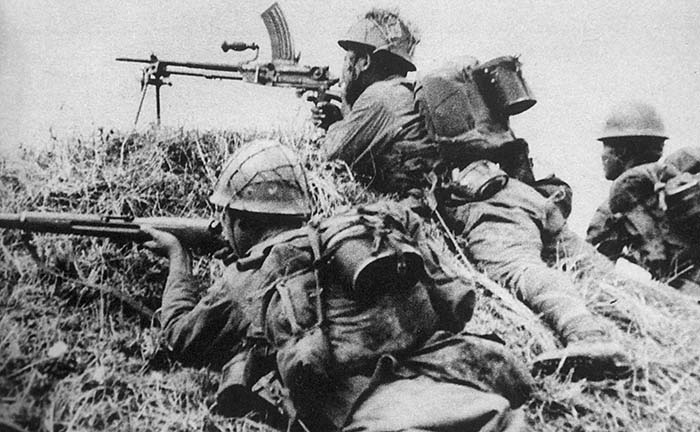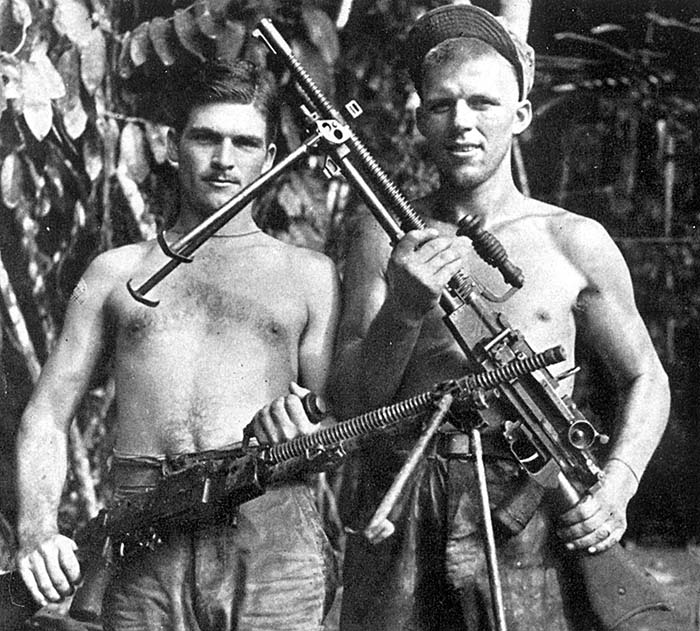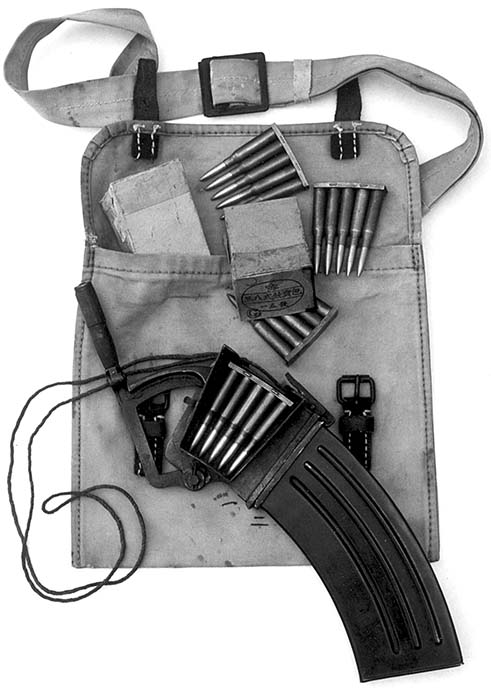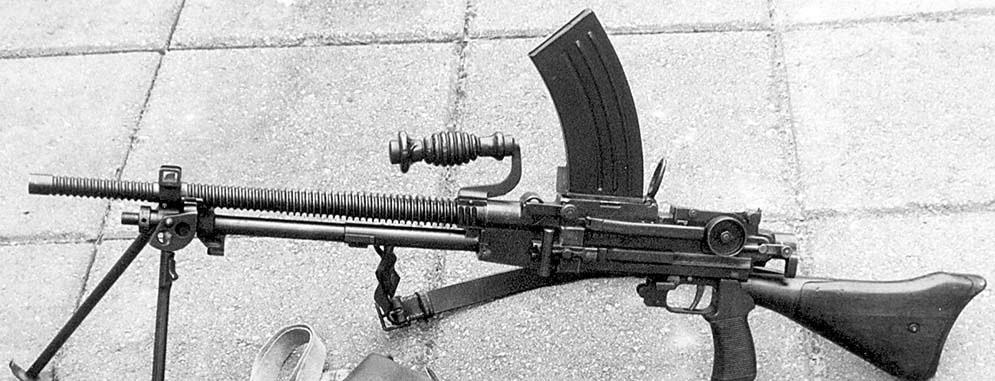Japanese Nambu Type 96 LMG with case for two spare magazines. Photo: E.F. Libby
By Edwin F. Libby
In the jungle fighting of the Pacific War the deadliness of the “Nambu Light,” as it commonly was known, was legendary. Its accuracy, mobility, reliability, and skillful use by Japanese gunners who sought glory in death made a fearful combination. At a distance the hollow popping of the .25 caliber Nambu through heavy jungle foliage often was mistaken by the trooper uninitiated to this battle environment for the report of a Thompson submachine gun, and this misidentification occasionally led to unnecessary casualties from “friendly fire” among our forces. Even in the static defenses which characterized Japanese tactics of the later Pacific engagements the Type 96 Nambu gunners gave good accountings of themselves, often moving their positions and firing from clever concealment where they were least expected. A Nambu Type 96 light machine gun was the penultimate souvenir for anyone who came up against this weapon in combat, but sending home such a souvenir from the combat areas was an opportunity found by few. Owning and shooting a Japanese Nambu Type 96 today establishes a connection to the violent Pacific battles, now distant in time as well as in space, which were hard fought in exotic lands of rain forests and jungles, and on remote and obscure tropical islands, atolls, and archipelagoes in defense of our American culture, society, and freedoms. This article is written to enhance appreciation of the historical significance of the Nambu Type 96 light machine gun, one of the most important Japanese infantry weapons of the Pacific War, and to do so as a remembrance of those who fought that war.

Japanese Type 96 Nambu LMG in action early 1942 in China. Photo: Japanese wartime pictoral magazine.
Type 96 History
Combat experience in China during the 1930’s heightened the awareness of the soldiers of the Imperial Japanese Army to the limitations of their 11th year Taisho (1922) Model Nambu light machine gun, a gas-operated Hotchkiss derivative fitted with a unique but somewhat complicated ammunition feed hopper which accepted 6.5mm Japanese service rifle cartridges in five-round stripper clips. This gun was accurate and reliable, but it was difficult to maintain on the battlefield, its action having been susceptible to dirt and debris, and its mechanism requiring oiled cartridges, which added another dimension to its maintenance problems. The Chinese enemy frequently were equipped with the excellent Czechoslovakian ZB 26 light machine guns in the powerful 7.92mm German service caliber, which either were imported from the Czech State Arms Factory at Brno or were made under license in some of the Chinese arsenals. The Japanese captured great numbers of the ZB 26 light machine guns and immediately put them into service, having recognized quickly the advantages of superior reliability. The ZB’s convenient and ample supply of loaded box magazine, and the ease of handling this well-balanced weapon had it all over their own light gun. Dissatisfaction with gun production costs and perhaps with the handling and general performance of the 11th Year Taisho Model Nambu precipitated a Japanese Army requirement for a new light machine gun, and a competition for a new design was held. Although there were several competing designs tested, the outcome of the competition resulted in the 1936 appearance and subsequent official adoption of an excellent new weapon – the Type 96 Nambu light machine gun. This weapon officially was designated Kyuroku Shiki Keikikanju, or “Type 96 light Machine Gun,” and it commonly was called Kyuroku Shiki Keiki, or “96 Type Light,” by the Japanese soldiers and marine troops who used it.

Prismatic Optical Sight used with the Type 96 Nambu LMG. Photo by E.F. Libby
The Type 96 Nambu light machine gun was of indigenous design and was created by Japan’s most prominent arms designer, Lieutenant General Kijiro Nambu who, at the time in 1936, had retired from a long Army career and was owner of a factory in Tokyo which manufactured training rifles. In 1937, General Nambu’s Company merged with Chuo Kogyo Kabushiki Kaisha, Ltd., also in Tokyo, and this large, state-supported corporation became the first manufacturer of the Type 96. Eclectic in his approach to firearms design, General Nambu sought to incorporate the best mechanical features of his approach to firearms design. He sought to incorporate the best mechanical features of his earlier 11th Year Taisho Model and of the Czech ZB light machine guns in developing this Type 96. Although he employed in the Type 96, the gas cylinder and piston-driven operating rod beneath the barrel of his 11th Year Taisho Model, features common to the best foreign designs, Nambu used a vertically sliding breech lock which held the action closed at the moment of firing. The lock was unique among light machine gun designs for it was made in the shape of a hollow square and was actuated by the operating rod which passed through it. This locking system was very reliable and it provided for adequate primary extraction which eliminated the need for the oiled cartridges of the 11th Year Model.

Type 96 Nambus captured at Guadalcanal. Photo: U.S. Military Intelligence Service
General Nambu was mindful, however, that the success of his design would be measured by soldiers in the field who judged these weapons by their reliability, accuracy, ease of handling, weight, and overall effectiveness in combat, rather than by the technical excellence of design pursued by designers and engineers. He knew from experience that the criteria of soldiers, designers, and engineers would have to be met if a weapon were to win a competition for adoption. The politics of the military establishment where decisions were made would have to matter, but General Nambu was an old campaigner in such matters. The sterling reputation in firearms design, which was embossed indelibly on his career, assured him of success. General Nambu’s light machine gun design won the Army’s competition and this weapon was adopted in 1936 to replace the 11th Year Model. The Type 96 light machine gun went into mass production in 1938 and was delivered shortly thereafter to troops in the field to support the invasions of Malaya and the Philippines. In December of 1941 the military forces of the Western World encountered the Type 96 light machine gun in combat – in defense of the British Crown Colony of Hong Kong by commonwealth troops, in the defense of Malaya by an Anglo-Indian army, and in the Philippines by a composite force of U.S. and Philippino troops. In August of 1942 U.S. Marines faced the Type 96 at Guadalcanal in the first U.S. invasion of Japanese territory of the Pacific War. The Marines commonly referred to this weapon as the “Nambu Light.”
Physical Characteristics and Accessories
Gas-operated and air-cooled, the Type 96 Nambu Light was a full automatic, magazine-fed shoulder weapon fired principally from the prone position on its bipod. Its pistol grip was conveniently mounted beneath the rear of the receiver to provide a sturdy hold on the weapon, and its long leather sling provided shoulder support for the gun’s weight. Its bipod folded to provide a comfortable fore grip protected from barrel heat, and this weapon was very effective when fired from the hip in an assault. The Type 96 fired with unusual accuracy the standard Japanese 6.5mm x 50mm Semi-rimmed Type 38 service cartridge used with both rifles and machine guns. The ammunition was supplied to the gun by a detachable 30-round box magazine mounted on top of the gun’s receiver. As long as the Type 38 improved, “reduced-charge” ammunition was used, the gun worked reliably and without lubrication of the ammunition. Despite occasional supply of poor ammunition insufficiently waterproofed and protected inadequately against the heat of the tropics, the Type 96 was exceptionally reliable in its functioning. A spare barrel assembly was carried with the gun, ostensibly to provide a quick change to extend sustained fire on the battlefield, but the spare was often lost or left behind in the confusion of jungle combat.

Ammo bag for 150 rounds of 6.5mm ammunition for the Type 96 shown with magazine and attached loader. Photo by E.F. Libby.
The sights on the Type 96 Nambu Light were of iron with an inverted V blade protected by side guards at the front, and the rear sight was a drum-controlled peep which was adjustable for windage as well as for elevation. The front sight blade encased a tiny glass cylinder that contained a phosphorescent substance to gather light under low-light conditions and improve the sight picture for the gunner. The sights were offset to the left because of the top-mounted magazine and hence a prismatic 2.5 power optical sight was issued to allow for this feature. The optical sight was carried by the machine gun team leader. The typical machine gun team consisted of a team leader, who was usually a sergeant, and three or four men trained as gunners and who kept the gun in action. The sight was effective only under condition of good light and clear visibility – conditions seldom found in the rain forest and jungles – and the sight infrequently was used in these environments.
A Complement of 12 or more magazines were issued with each type 96 Nambu light machine gun, and they were carried in canvas and leather constructed pouches with carrying straps. Each of these pouches held two magazines which were non-disposable and were charged with magazine loaders carried by the members of the machine gun team. Supplemental ammunition was carried in canvas shoulder bags which held 150 rounds – ten 15-round boxes of 6.5 mm Type 38 improved “reduced charge” ammunition. A spare parts wallet and a field maintenance kit – both carried in canvas belt pouches – were standard gun support accessories.
To facilitate the portability of the gun, a rigid carrying handle with a grooved wooden grip was fixed on the tip of the barrel just ahead of its joint with the receiver. A bayonet stud was machined into the forward portion of the gas cylinder beneath the gas block on the barrel, and the bayonet’s muzzle ring was supported by the front of the gas regulator plug. Early-manufactured Type 96 Nambu Lights had a barrel for a muzzle cover and cleaning rod guide secured by a stud and socket lock. Later-manufactured guns were threaded at the muzzle and fitted for a flash Hider. Weighing only 20 pounds with sling, the Type 96 was two and a half pounds lighter than its predecessor, the 11th Year Taisho Model, and its weight favorably was competitive with the best light machine guns of its kind used in the Pacific War.
Epilogue
Even as it went into production, the Type 96 Nambu Light was displaced by the Imperial Japanese Army’s adoption of another light machine gun – the Type 99 Nambu – which was made in a heavier 7.7mm (.303) caliber. The type 96 was phased out of production in 1943, its manufacturing machinery having been converted and reassigned to the production of the Type 99, which was really a slightly redesigned and strengthened Type 96. Probably because of its great accuracy, and because it was lighter and had less recoil than its Type 99 successor, the Type 96 Nambu Light that was in service remained the favorite of the Japanese gunners. U.S. Marines and soldiers prized their captured Type 96 Nambu and often carried them many miles to fire the few rounds of ammunition they had at their most resolute Japanese enemies.
| This article first appeared in Small Arms Review V4N3 (December 2000) |











